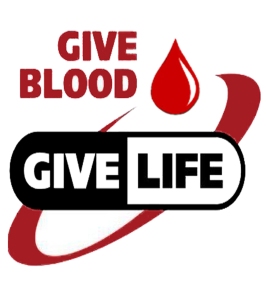
Courtesy: The Internet
Because we all read and write on some level, and we all need blood.
Here’s what I mean: Horror writers, and writers of practically every genre out there, except (let’s hope) children’s books, employ the use of blood either symbolically or because our characters run out of things to use for paint. We all have a visceral reaction when we see blood on the screen and in real life, and that reaction’s never good.
(Really, can you think of a circumstance when it’s fine to be overcome with joy and exclaim “Yippie! Blood!” or “Oh, thank heavens, Murray, the baby’s bleeding!” I can’t.)
That’s because blood belongs in the body and not out of it–with one exception: when you donate it, which, in my 38 years of life, I have never done.
Until last Thursday when my company hosted a blood drive.
Some history: I don’t mind needle pricks. This isn’t to say I enjoy needles. I don’t. Especially when they get stuck in the curve of the arm they use to draw blood. I cannot look at that. Ever. You go Labcorp or Quest Diagnostics and they sit you in that chair that has the funky elbow table on it, they slip that rubber band around your arm to find a vein, and, sheesh, is it getting hot in here?, and then you feel the rubber band digging into your skin, somewhat painfully, and you notice a throbbing and then they dab that cool stuff over the exposed veins, which you imagine look like a hideous purple spiderweb, and the lab technician reaches for the needle andjdkshfdjsabgrae pu 9gneahbhdfsk;a
Sorry, I just fainted headfirst onto my keyboard and need to mop up the sweat. Give me a minute.
Okay, I’m back. While I’m dramatizing (somewhat) my distaste for getting blood drawn, there’s some truth to it. I can’t look at it for fear that I indeed will faint. So why voluntarily put myself through this process, especially when they leave the needle in for an extended amount of time to drain me?
Because I’m a dad. That’s my reason. Things change on so many levels when you become a parent. Responsible parents, and I’d like to think the vast majority of parents are, wouldn’t hesitate to give blood if the doctor said, “Mr. and Mrs. (insert your last name), your child needs a pint of blood, and we need it from you.” No question. I’d be in that chair snapping on the rubber band myself.
So I got to thinking on the day of the blood drive that there are no doubt scores of little boys and girls, and grown adults, who will need blood. I’ve seen numbers ranging from 2% to 5% of Americans who are able to donate blood actually do so. There are a slew of statistics that can be found that illustrate just how badly blood is needed and how it’s always in short supply.
I didn’t think, I just did. For those of you who are squeamish and want to know what it’s really like to donate blood when you hadn’t planned on it, here you go:
1. You fill out paperwork that includes a lengthy questionnaire about your medical/sexual history. Providing you: A, don’t have HIV; B, aren’t a heroin addict; C, aren’t Iggy Pop; D, haven’t traveled to the United Kingdom between 1980 to 1986 (I’m not kidding, there was a question like that), and the like, you should be able to donate.
2. A technician goes over your form with you, asks a few questions to confirm this or that, takes your blood pressure, and then there’s warm-up act for the needle in the arm: the dreaded finger prick. Yup. They need to sample your blood before they do anything, so the technician dabs your ring finger with that cool numby stuff, squeezes the tip until it looks like a purple grape, and sticks it. Unpleasant? Yes. But you are rewarded with a Band-aid so it all works out. In the end, once you’re cleared, in your mind the technician takes on the appearance of the Grim Reaper and slowly points a bony finger to the chairs in the waiting area. You will pass a table of unhealthy food–salty chips, crackers, cookies, fruit juices–that will eventually be your reward, but not yet.
3. You get to sit and look at the four or five donors ahead of you who are sitting or lying on reclining tables, and all of them were full of calm, seemingly happy people getting their blood drawn. At least they were when I was there. Mostly older ladies and gentlemen, chatting with the nurses while plastic tubing snaked from their arms to blood-filled bags. (By that point I looked like Data from Star Trek: The Next Generation.)

Courtesy: Google search
4. It’s your turn. The technician who screened me had the presence of mind to write on my sheet “lay him flat.” Everyone else was sitting up, but they made sure I was supine for my donation. Why this was important will be explained later. So you lie down, unbutton your shirt sleeve and roll it up to reveal your soft flesh, and wait. And you not only look at the empty plastic bag that will be affixed with a bar-coded sticker with your details, but you eye at least six empty plastic vials, similarly bar-coded. All you’re thinking is they’re going to run six different tests on my blood before they can confirm whether they’ll use the pint they’re about to get from me. I’m already nervous, and that’s only compounded when I realize I’m paired with the “new” technician who had to make sure he was doing things right by asking the nurse. I like to joke around with people, it usually lightens the mood. I wasn’t in the mood to joke. And I’m glad the technician (a pleasant fellow) wasn’t either. If I was that technician, I’d probably be smiling and saying things to the nervous donor like: “Well, let’s hope you don’t end up like the last guy,” or “Don’t worry, I haven’t had an epileptic seizure since this morning.” Nope. Nope. Nope. There is a time and a place for everything. And joking with a first-time blood donor isn’t one of them. At that point, I’m just thinking, let’s get this over with!
5. Here it comes! The bag is hooked up with tubes, the vials are ready for fluid, and they found my veins by pumping a blood-pressure cuff. I looked out the window next to me the entire time. I felt the swab of cool, heard the guy say “little pinch,” and stick! That’s it. That millisecond of pain is over! The lingering discomfort takes its place. And it’s not comfortable. I was given a soft rod to squeeze every ten seconds, and I can only deduce this ensures your blood continues to pump. So, I’m lying there, counting to ten and squeezing, feeling this tube thing stuck in my arm, knowing full well what it’s up to, and I begin to feel warm. That’s right. I’m heating up, so much so that I notice my forehead is beading with sweat. And I’m woozy. Damn straight. This isn’t fun. I’m glad I’m helping someone I’ll never meet, but does it have to take so damn long to fill a bag with a pint of blood? Answer: Yes. You just keep thinking to yourself: it’ll be over soon, you’ll eat lots of sugary, salty snacks, and I’m going to pass out. There was a time when I thought I might, but I didn’t. I forced myself to squeeze and ride out the discomfort. Because, honestly, it doesn’t hurt. The tech noticed me sweating and, I’m positive, looking like a skeletal albino, and thought it prudent to slip a pillow under my head, place ice packs under my neck and high on my chest, and pray that he wouldn’t have to scream “get the shock paddles!” And after what felt like 10 minutes, the tech came back and (joy!) he slipped the needle out. He placed gauze on my tiny wound and asked me to hold it in place, and I did. He also raised my legs 45 degrees. Eventually he lowered my legs and inclined me 45 degrees to sit, and then to 90 degrees over a period of 15 minutes. One of the nurses said I probably would’ve passed out had I been sitting up during the donation. I don’t doubt it. Once I was deemed capable of walking fifteen feet to the goodie table without collapsing, I chowed down. One of the nurses was having lunch with me and commented “you still look pale, and your lips are blue.” I said, “well, I do feel a little woozy.” She said, “Oh, then we have to lay you back down on the table.”
“NO!” That’s the quickest I think I’ve ever said “no!” in my life. I assured them I was fine and would happily eat junk food with them until they cleared me. And cleared me they did after 2 bags of pop chips and a sleeve of Lorna Doons.
It was over. Well, not really. Salem’s Lot fans, remember the part in the book when Danny Glick stumbles weakly out of the forest and is ghost white and incoherent? That’s what I was like for the rest of Thursday and all day Friday. I am not joking. I felt like Barlow had gotten ahold of me. I had planned on taking Friday off anyway for unrelated reasons and am thankful I did because I was literally down a pint of blood for the first time in my life and my body didn’t know what to think, other than “Just go really slow.”
I’m not going to get preachy and say “everybody should give blood!”
No, if you honestly don’t feel you can handle it (like I did), then there’s really no shame in not doing it. I know a lot of people are scared to do it. But I’d like to think that I’m living proof that you can get through it. No, it won’t be fun. Since when is taking anything out of your body with medical instruments over a drawn-out period of time considered fun? But, trust me, it’s not as bad as you think it will be. And you will be helping someone.
The blood mobile will come back to my workplace within the next six months to a year. I’m not certain I will be the first in line with my sleeve rolled up. I’ll probably have to talk myself into it again. And that thought will involve some child, like my toddler son, in need of life-saving blood, and I’ll probably go ahead and do it, knowing it’ll suck. But it’s not the worst thing that can happen to you at work. Just make sure you don’t have anything big planned for the next day.









